Quick Look
Grade Level: 6 (5-8)
Time Required: 45 minutes
Expendable Cost/Group: US $0.00
Group Size: 2
Activity Dependency: None
Subject Areas: Data Analysis and Probability, Physical Science, Science and Technology
NGSS Performance Expectations:

| MS-ETS1-1 |
| MS-ETS1-2 |
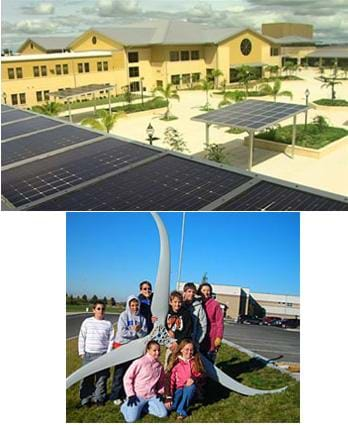
Summary
Students use real-world data to calculate the potential for solar and wind energy generation at their school location. After examining maps and analyzing data from the online Renewable Energy Living Lab, they write recommendations as to the optimal form of renewable energy the school should pursue.Engineering Connection
Many different methods are used to collect energy; some methods are better suited to a particular area than others. Engineers use data to understand the problem and evaluate viable solutions. When designing systems to produce or transmit sustainable energy, or power, engineers look at opportunities to harness renewable resources such as wind, sunlight, biofuels, geothermal heat and flowing water. Building a wind turbine in an area with little wind would not be the best choice. Part of an engineer's job involves determining what technologies are best suited for any given area and conditions.
Scientists and engineers around the world gather data through observation and experimentation and use it to describe and understand how the world works. The Renewable Energy Living Lab gives students a chance to evaluate U.S. renewable energy sources. Using the real-world data in the living lab enables students and teachers to practice analyzing data to solve problems or answer questions, in much the same way that scientists and engineers do every day.
Learning Objectives
After this activity, students should be able to:
- Describe the difference between wind turbines and solar panels.
- Use maps to analyze the potential for generating various types of renewable energy.
- Explain the factors contributing to renewable energy feasibility.
Educational Standards
Each TeachEngineering lesson or activity is correlated to one or more K-12 science,
technology, engineering or math (STEM) educational standards.
All 100,000+ K-12 STEM standards covered in TeachEngineering are collected, maintained and packaged by the Achievement Standards Network (ASN),
a project of D2L (www.achievementstandards.org).
In the ASN, standards are hierarchically structured: first by source; e.g., by state; within source by type; e.g., science or mathematics;
within type by subtype, then by grade, etc.
Each TeachEngineering lesson or activity is correlated to one or more K-12 science, technology, engineering or math (STEM) educational standards.
All 100,000+ K-12 STEM standards covered in TeachEngineering are collected, maintained and packaged by the Achievement Standards Network (ASN), a project of D2L (www.achievementstandards.org).
In the ASN, standards are hierarchically structured: first by source; e.g., by state; within source by type; e.g., science or mathematics; within type by subtype, then by grade, etc.
NGSS: Next Generation Science Standards - Science
| NGSS Performance Expectation | ||
|---|---|---|
|
MS-ETS1-1. Define the criteria and constraints of a design problem with sufficient precision to ensure a successful solution, taking into account relevant scientific principles and potential impacts on people and the natural environment that may limit possible solutions. (Grades 6 - 8) Do you agree with this alignment? |
||
| Click to view other curriculum aligned to this Performance Expectation | ||
| This activity focuses on the following Three Dimensional Learning aspects of NGSS: | ||
| Science & Engineering Practices | Disciplinary Core Ideas | Crosscutting Concepts |
| Define a design problem that can be solved through the development of an object, tool, process or system and includes multiple criteria and constraints, including scientific knowledge that may limit possible solutions. Alignment agreement: | The more precisely a design task's criteria and constraints can be defined, the more likely it is that the designed solution will be successful. Specification of constraints includes consideration of scientific principles and other relevant knowledge that is likely to limit possible solutions. Alignment agreement: | All human activity draws on natural resources and has both short and long-term consequences, positive as well as negative, for the health of people and the natural environment. Alignment agreement: The uses of technologies and any limitations on their use are driven by individual or societal needs, desires, and values; by the findings of scientific research; and by differences in such factors as climate, natural resources, and economic conditions.Alignment agreement: |
| NGSS Performance Expectation | ||
|---|---|---|
|
MS-ETS1-2. Evaluate competing design solutions using a systematic process to determine how well they meet the criteria and constraints of the problem. (Grades 6 - 8) Do you agree with this alignment? |
||
| Click to view other curriculum aligned to this Performance Expectation | ||
| This activity focuses on the following Three Dimensional Learning aspects of NGSS: | ||
| Science & Engineering Practices | Disciplinary Core Ideas | Crosscutting Concepts |
| Evaluate competing design solutions based on jointly developed and agreed-upon design criteria. Alignment agreement: | There are systematic processes for evaluating solutions with respect to how well they meet the criteria and constraints of a problem. Alignment agreement: | |
Common Core State Standards - Math
-
Fluently add, subtract, multiply, and divide multi-digit decimals using the standard algorithm for each operation.
(Grade
6)
More Details
Do you agree with this alignment?
-
Use ratio reasoning to convert measurement units; manipulate and transform units appropriately when multiplying or dividing quantities.
(Grade
6)
More Details
Do you agree with this alignment?
International Technology and Engineering Educators Association - Technology
-
Apply the technology and engineering design process.
(Grades
3 -
5)
More Details
Do you agree with this alignment?
-
Evaluate designs based on criteria, constraints, and standards.
(Grades
3 -
5)
More Details
Do you agree with this alignment?
-
The management of waste produced by technological systems is an important societal issue.
(Grades
6 -
8)
More Details
Do you agree with this alignment?
-
Requirements for design are made up of criteria and constraints.
(Grades
6 -
8)
More Details
Do you agree with this alignment?
-
Analyze how different technological systems often interact with economic, environmental, and social systems.
(Grades
6 -
8)
More Details
Do you agree with this alignment?
-
Analyze how the creation and use of technologies consumes renewable and non-renewable resources and creates waste.
(Grades
6 -
8)
More Details
Do you agree with this alignment?
-
Analyze how an invention or innovation was influenced by its historical context.
(Grades
6 -
8)
More Details
Do you agree with this alignment?
-
Create solutions to problems by identifying and applying human factors in design.
(Grades
6 -
8)
More Details
Do you agree with this alignment?
-
Energy can be grouped into major forms: thermal, radiant, electrical, mechanical, chemical, nuclear, and others.
(Grades
9 -
12)
More Details
Do you agree with this alignment?
-
Energy resources can be renewable or nonrenewable.
(Grades
9 -
12)
More Details
Do you agree with this alignment?
State Standards
Colorado - Science
-
Earth's natural resources provide the foundation for human society's physical needs. Many natural resources are nonrenewable on human timescales, while others can be renewed or recycled
(Grade
6)
More Details
Do you agree with this alignment?
Materials List
Each group needs:
- computer with internet access (or printed or projected renewable energy potential maps as found on the Renewable Energy Living Lab website)
- Power Your School Worksheet, one per student
Worksheets and Attachments
Visit [www.teachengineering.org/activities/view/csm_powershool_activity1] to print or download.Pre-Req Knowledge
A basic understanding of map reading and ability to navigate the internet.
Introduction/Motivation
From where does renewable energy come? (Listen to student ideas.) That's right, renewable energy comes from natural resources such as wind, plant material (wood), water (rivers, tides, dams), geothermal (underground) and sunlight—and is naturally replenished.
Renewable energy resources are currently a hot topic in science and engineering as society looks for ways to produce affordable power without permanently damaging our environment. As scientists and engineers look for ways to better utilize renewable energy resources, they look at a variety of data to determine if these energy resources are feasible for given areas.
To consider whether a renewable energy source is feasible, scientists and engineers ask a variety of questions, such as:
- How does it work?
- How much is there? How much power potential?
- How much does it cost?
- What is the environmental impact?
- Is the resource available in the area where we need it?
We will learn more about renewable energy potential sources using the online Renewable Energy Living Lab during the next couple of class periods. We will look at data acquired and presented by the Department of Energy National Laboratories.
Procedure
Background
As students compare solar and wind power potentials for their school location, they may be confused when they realize the units provided for solar and wind power are not the same. For wind power, they must convert from watts per square meter (W/m2) to kilowatt-hours per square meters per year (kW/m2/year) in order to answer worksheet question 3. In order to do this, students first must use Table 1-1 Classes of Wind Power Density to determine the wind power density in W/m2 based off the wind speed (m/s) that they find on the map. This table is given under the Wind Speed Offshore icon in the lower left corner, but for easy accessibility it is provided below. Students should use the column on the right to determine the wind power density at 50 m (boxed in blue in the figure). For example, if a student found a speed of 7.0 m/s on the map, that would correlate to a density of 400 W/m2. Students can just round and estimate if numbers fall in between (i.e., do not have to interpolate to get the density). Students should be aware that watt-hours (Wh) or kilowatt-hours (kWh), are units of energy, while watts (W) or (kW) are units of power. Energy is determined by multiplying power by the time period of this power consumption. To show an example of this conversion, let's say a student finds that a location has a potential for 400 W/m2 of wind power. S/he must multiply by the hours in a day and by the days in a year:
400 W/m2 x 24 hours/day x 365 days/year = 3500000 Wh/m2/year = 3500 kW/m2/year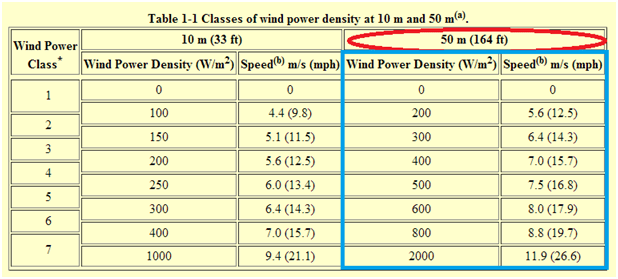
Before the Activity
- Prepare the computers and make copies of the Power Your School Worksheet.
- Divide the class into groups of two students each.
- Inform students that in order to complete the assignment, they will use the Renewable Energy Living Lab to determine where potential sites are. Follow the instructions below to get started!
With the Students
- Provide students with the background and story for the activity and the (hypothetical) challenge: Our school has received a grant from the Department of Energy to help offset power costs by funding the placement of either solar panels on the school roof or wind turbines on school grounds. This means that the DOE will help our school pay for a renewable energy system. But what system will work best for the money? Which option will generate the most energy for the investment? Your task is to act as engineers and analyze data about the potential amount of solar and wind energy available at our school location. Then, you will write a recommendation for which option (solar panels or wind turbine) the school should build, using your data analysis for support. To solve this problem, we'll use real-world data hosted on a website called "a living lab."
- Hand out the worksheets as a guide for the activity. Review the worksheet with the class.
- Show students how to use the Renewable Energy Living Lab, as described in the next steps.
- Navigate students to http://www.teachengineering.org/livinglabs/index.php > click on Renewable Energy Living Lab.
- Review the five renewable energy icons; discuss why each icon is appropriate for the energy type it represents (wind, biomass, hydro, geothermal, solar).
- As an introduction to renewable energy, review the descriptive paragraphs about each energy source the page. Visit each "How It Works" link to explore the engineering

A brief description of wind energy, as found on the Renewable Energy Living Lab introduction page. Note the "How It Works" hot link. - Choose age group K-12.
- Zoom in on your state by double clicking on the map and/or using the mouse hand and the zoom and pan tool. Find your school.
- Check the boxes under the Resources folder (located on the left under the Data Layers tab) to switch between the maps depicting the potential for the five different forms of renewable hydropower, biomass, geothermal, wind and solar. Use the icons in the lower left corner to read more information about each form of energy.
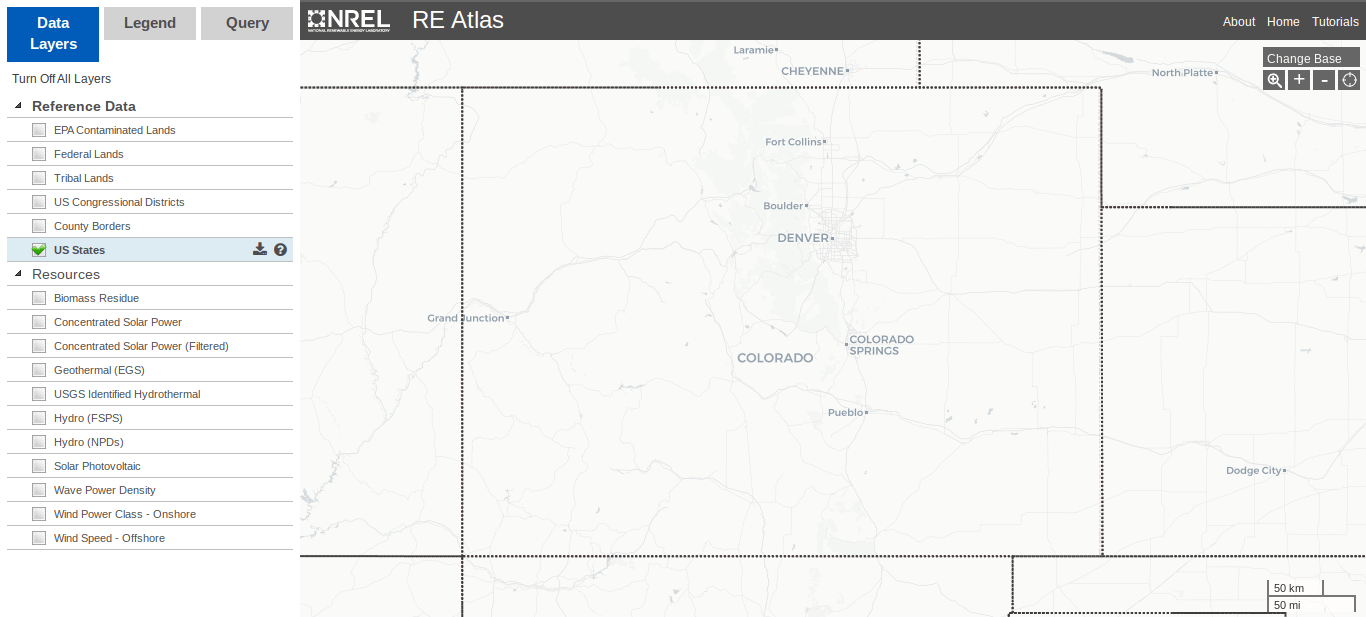
On the map, use the zoom and pan tool in the upper right-hand corner to find locations - Give students time to explore the living lab before they begin to analyze data. Point out the legend under the Legend tab. Point out hot links at the bottom of the legend box for additional resources about each energy type.
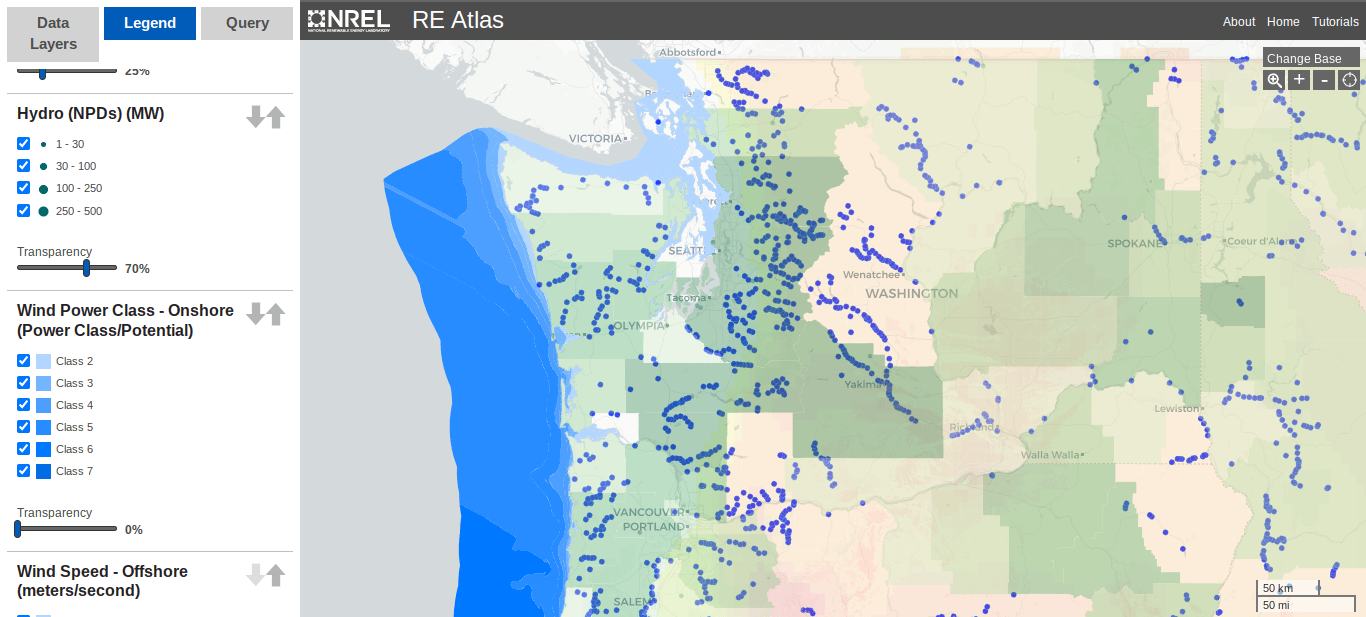
Example Renewable Energy Living Lab screen showing a map legend and additional links. - While examining the solar energy map, have students note how the colors indicate various levels of energy efficiency. Using the map, have students answer the data analysis worksheet questions:
- Describe the amount of solar energy that is received by your school. (Be detailed. Include both relative descriptions [that is, low, medium, high] and numerical data [that is, 5.0 kWh/m2/day]).
- Describe the amount of wind energy received by your school. (Be detailed. Include both relative descriptions [that is class type] and numerical data [that is, 5.0 m/s]).
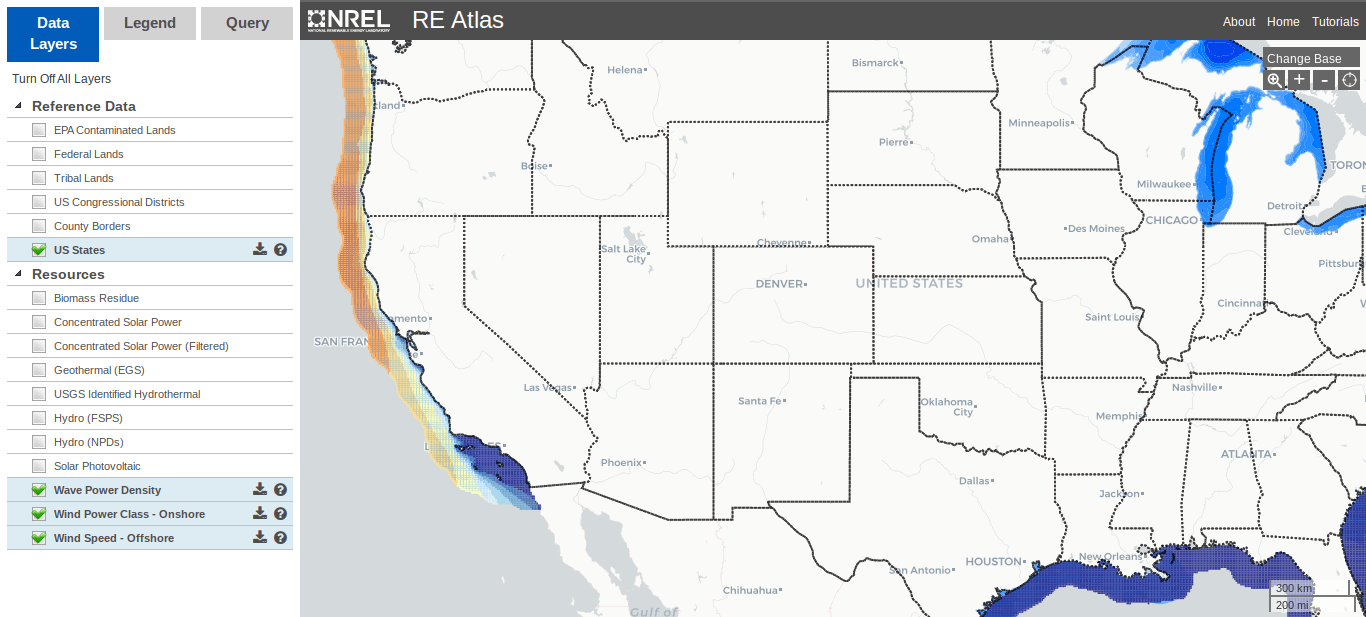
Figure 1: A wind power map for the region north of Denver, CO.
- Using the numerical data from worksheet questions 1 and 2, have students calculate the amount of solar and wind energy the school could possibly generate in one year, assuming the following conditions:
- Your school roof has a surface area of approximately 4,300 square meters; 50% of that space is useable space.
- Your school football field can hold approximately four wind turbines safely. Each wind turbine has an area of approximately 1,000 m2.
- Your units should be in kilowatt hours/year. (Remember, 1000 W = 1 kW)
- Have students complete the remaining worksheet section—writing their recommendations.
- Conclude by having students share their recommendations in small groups or with the class.
Vocabulary/Definitions
biomass: Biological (organic) material from living or dead organisms (especially plants) used as an energy source. Biomass used for electricity generation varies widely by region. Examples: Forest and wild plant growth (trees, branches, stumps), industrial wastes (such as from lumber and paper mills), urban waste (park trimmings, yard clippings, municipal solid waste, animal matter, sewage, food scraps), agricultural residues and fuel crops (corn, sugarcane, bamboo, hemp, wheat, straw, rice husks, grasses, algae, seaweed, animal fats, vegetable oils), etc.
fossil fuel: A type of fuel formed by the decay and decomposition process of dead organisms buried in the Earth for millions of years. Examples: Petroleum, natural gas, coal.
geothermal energy: Thermal (heat) energy from heat present under the Earth's surface.
hydropower: Power created from the movement (falling) of water. Dams are often used to create hydropower that can be converted to electricity.
renewable energy: Energy obtained from natural resources that are continually replenished, for example, regardless of how much of the Sun's heat energy is "used" today, more is received by the Earth tomorrow. Examples: Sunlight (solar energy), water (hydropower), geothermal, biomass.
wind turbine: A device similar to a windmill that moves with the wind to convert the kinetic energy created by the wind to mechanical energy. This mechanical energy can be converted to electrical energy as well.
Assessment
Activity Embedded Assessment
Worksheet: Have students use the attached Power Your School Worksheet to guide the activity, which includes calculating the amount of solar and wind energy the school could potentially generate in one year. Check their answers to gauge their level of understanding.
Analyses & Recommendations: Solar energy or wind energy? Have students summarize the results and conclusions of their analyses as recommendations (last worksheet section). Evaluate their recommendations against the following criteria:
- Recommended option (solar panels or wind turbines).
- Explanation for the renewable energy source selection, based on data.
- Recommendation for where to locate the option.
Post-Activity Assessment
Summary Presentations: As would typically be done by engineers, have students present their recommendations in small groups or with the class. This, along with their worksheet answers, reveals their level of comprehension
Activity Scaling
- For lower grades, do the calculations as a class, rather than individually.
- For upper grades, have students access the NREL Renewable Energy Atlas to explore interactive maps. The data sources allow students to download data sets into Excel for further manipulations.
Additional Multimedia Support
Teacher resources: http://www.teachengineering.org/livinglabs/renewable_energy/educators.php
Subscribe
Get the inside scoop on all things TeachEngineering such as new site features, curriculum updates, video releases, and more by signing up for our newsletter!More Curriculum Like This

Students use real-world data to evaluate whether solar power is a viable energy alternative for several cities in different parts of the U.S. Working in small groups, they examine maps and make calculations using NREL/US DOE data from the online Renewable Energy Living Lab.

Students analyze real-world data for five types of renewable energy, as found on the online Renewable Energy Living Lab. They identify the best and worst locations for production of each form of renewable energy, and then make recommendations for which type that state should pursue.

Students use real-world data to evaluate the feasibility of solar energy and other renewable energy sources in different U.S. locations. Working in small groups, students act as engineers evaluating the suitability of installing solar panels at four company locations.

Students become familiar with the online Renewable Energy Living Lab interface and access its real-world solar energy data to evaluate the potential for solar generation in various U.S. locations. Through this activity, students and teachers gain familiarity with the living lab's GIS graphic interfa...
Other Related Information
This activity is designed around the Renewable Energy Living Lab, a resource of current and real-world scientific data, in this case a culmination of available renewable energy data from across the U.S. The data is available in a database with a graphical interface using a scaling map for viewing of regions as large as the continental U.S. and as small as a town. It is rare that students have access to query such as extensive body of scientific data to support their own inquiry-based questions. Additional background information is provided in the living lab interface including source information used to compile the data.
Copyright
© 2013 by Regents of the University of Colorado; original © 2012 Colorado School of MinesContributors
Mike Mooney; Minal Parekh; Scott Schankweiler; Jessica Noffsinger; Karen Johnson; Jonathan KnudtsenSupporting Program
Civil and Environmental Engineering Department, Colorado School of MinesAcknowledgements
This curriculum was created with the support of National Science Foundation grant no. DUE 0532684. However, these contents do not necessarily represent the policies of the National Science Foundation, and you should not assume endorsement by the federal government.
Last modified: February 1, 2022










User Comments & Tips